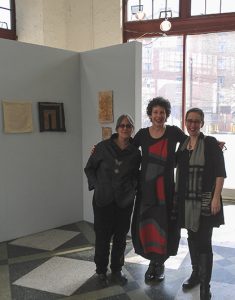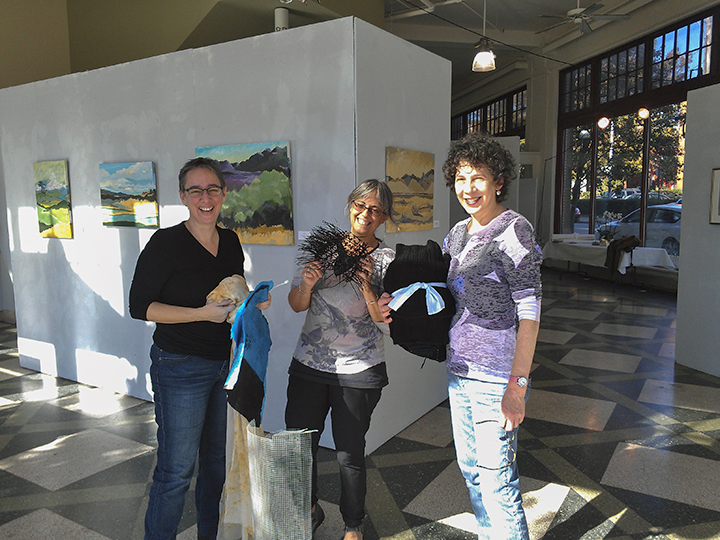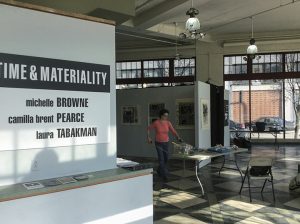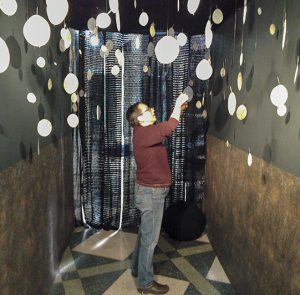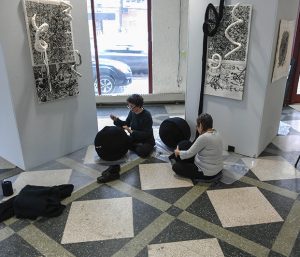Hey kids, let’s put on a show!
Following Staci Offutt’s thoughtful review of Time and Materiality, we got to thinking about the process of self-curating an exhibition, especially when collaborating with fellow artists who happen to be friends. Would that be fun and exhilarating, an opportunity to see your work and theirs in a sharper light… or maybe not so much? As deadline stress set in, could fighting and biting break out? (OK so probably not in our guild, but one does hear stories.) Before our imaginations reached soap opera pitch, we asked Camilla Pearce to take us behind the scenes and unscrew the whole process. Here’s how Camilla tells it…
Coming up with a title for the show really wasn’t that difficult. We sat down with a pad of paper and brainstormed words that applied to our work and concepts that linked them thematically. While there were more esoteric options suggested by the MIT exhibition title generator,*** Time and Materiality best expressed the common threads in our work – even though each of us has different esthetics and chosen materials. When Penny asked me to write something about “self-curating” our exhibition, I realized that the collaborative process we used for picking a title was quite similar to how the rest of the show developed.
First of all – while our artworks are very different one from another, they share a great deal in common. Knowing each other for as long as we have through the Guild, we felt it was a good combination and would present well together. There are obvious overlaps – we all love rust, process, and experimentation with materials. There are happy affinities, not necessarily curated, especially in color palette. The show also benefits from our differences. From Laura’s magical walk–in installation, to Michelle’s vibrant graphic panels and life-sized figures, to my macrocosms of obsessive stitching, the variety of scale provides a necessary contrast.
Curating the show was an organic process. We met as a group once after I came on board in January (Michelle and Laura had been planning the exhibit for a while before inviting me to participate). We walked the space and drafted a rough diagram of the gallery and available walls. Each of us brought work in various states – completed, in process, and in concept. While the exhibition wasn’t directly chosen from what we assembled that day, it was helpful to see what everyone was working on, both to get a sense of whether it was cohesive, and to estimate how many more pieces we each needed to make before installation. We also agreed that we wanted our work to be relatively integrated, rather than each artist having her own “space” in the gallery. At this meeting we also developed a calendar and assignments for the exhibition – PR, design of materials, gallery-sitting, the menu, format and time of the opening, and potlucks (in lieu of a formal gallery talk) for community. The schedule included a week to install and time on the backend to take the show down.
That week for hanging was an absolutely necessary. We needed every minute, especially for Laura’s intricate installations. But an unanticipated benefit was the time to live with the work in the space and to make adjustments to the whole. While a good deal of our original layout stuck (Laura’s environment in the center of the gallery, Michelle’s Drawing Series prints and the “Sisters” and my Lou series each having a wall to themselves), many other aspects changed or were added to fill gaps. Other decisions were driven by elements we couldn’t control such as the wall color and scale of the gallery. At the 11th hour, Michelle and Laura had the genius idea of placing black foam-core panels behind the smaller works. They provided uniformity in the gallery space and a graphic backdrop for delicate pieces that would have gotten lost against a large grey wall.
The “foam-core solution” is just one example of how this kind of exhibition benefits from being a collective endeavor. As artists most of us spend a great deal of time alone in the studio. We set up our own aesthetic challenges and devise solutions on a regular basis. Mounting a solo show gives total artistic control and vision which is liberating, but being part of a collaborative like Time and Materiality stretches entirely different art muscles. This situation was the perfect storm (in a good way): amazing artist partners – Laura, Michelle, Donnie, Martha – and a space that lends itself to many configurations. It won’t always be like that. But I would encourage anyone interested in exhibiting – especially if the idea of making enough work to support a solo show is daunting – to consider finding kindred spirits to collaborate with. I promise you’ll learn a lot. I certainly did.
*** For more fun at home check this out: MIT Exhibition Title Generator
Photo below: Camilla Pearce, Michelle Browne, Laura Tabakman
